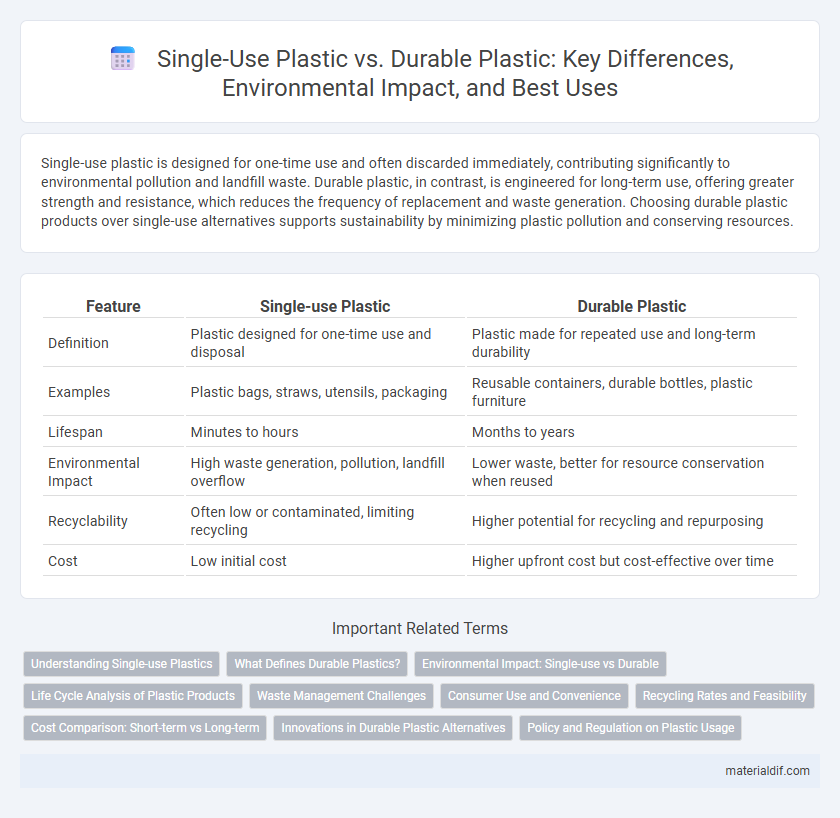Single-use plastic is designed for one-time use and often discarded immediately, contributing significantly to environmental pollution and landfill waste. Durable plastic, in contrast, is engineered for long-term use, offering greater strength and resistance, which reduces the frequency of replacement and waste generation. Choosing durable plastic products over single-use alternatives supports sustainability by minimizing plastic pollution and conserving resources.
Table of Comparison
| Feature | Single-use Plastic | Durable Plastic |
|---|---|---|
| Definition | Plastic designed for one-time use and disposal | Plastic made for repeated use and long-term durability |
| Examples | Plastic bags, straws, utensils, packaging | Reusable containers, durable bottles, plastic furniture |
| Lifespan | Minutes to hours | Months to years |
| Environmental Impact | High waste generation, pollution, landfill overflow | Lower waste, better for resource conservation when reused |
| Recyclability | Often low or contaminated, limiting recycling | Higher potential for recycling and repurposing |
| Cost | Low initial cost | Higher upfront cost but cost-effective over time |
Understanding Single-use Plastics
Single-use plastics, designed for immediate disposal after a single use, significantly contribute to environmental pollution due to their short lifespan and resistance to natural degradation. Common examples include plastic bags, straws, and packaging materials largely composed of polyethylene and polypropylene. Understanding the material composition and disposal challenges of single-use plastics aids in developing effective waste management and recycling strategies that minimize ecological impact.
What Defines Durable Plastics?
Durable plastics are defined by their high resistance to wear, impact, and environmental factors, allowing repeated use over extended periods without significant degradation. These plastics, including polyethylene terephthalate (PET) and high-density polyethylene (HDPE), maintain structural integrity under stress and are commonly used in products like containers, automotive parts, and construction materials. Their robustness distinguishes them from single-use plastics, which are designed for short-term use and rapid disposal.
Environmental Impact: Single-use vs Durable
Single-use plastics generate significant environmental pollution due to their short lifespan and high volume of waste, often ending up in oceans and landfills, harming wildlife and ecosystems. Durable plastics, designed for repeated use, reduce waste generation and resource consumption by extending product life cycles and lowering the frequency of disposal. However, durable plastics require effective recycling systems to minimize environmental impact, as improper disposal can still contribute to pollution and microplastic contamination.
Life Cycle Analysis of Plastic Products
Single-use plastics typically have a shorter life cycle with lower initial manufacturing emissions but generate significant environmental impact due to disposal and limited recycling rates. Durable plastics, designed for extended use, often have higher production emissions but distribute the environmental burden over a longer product lifespan, reducing overall waste accumulation. Life Cycle Analysis (LCA) of plastic products emphasizes the importance of evaluating raw material extraction, manufacturing, usage, and end-of-life management to determine sustainable plastic solutions.
Waste Management Challenges
Single-use plastic generates massive volumes of waste that overwhelm landfill capacities and complicate recycling efforts due to contamination and low material value. Durable plastic, while contributing to long-term waste accumulation, offers greater potential for reuse and recycling, reducing environmental impact when managed properly. Effective waste management must address the distinct challenges posed by the rapid disposal of single-use plastics and the persistent presence of durable plastics in the waste stream.
Consumer Use and Convenience
Single-use plastics offer unmatched convenience for consumers due to their lightweight design and disposability, making them ideal for on-the-go lifestyles. Durable plastics, although less convenient for immediate disposal, provide long-term value through repeated use and resistance to wear and tear. Consumer preference often balances the ease of single-use items with the sustainability benefits of durable plastic alternatives.
Recycling Rates and Feasibility
Single-use plastics generally exhibit lower recycling rates compared to durable plastics due to contamination and limited economic incentives, with global recycling rates often below 15%. Durable plastics, used in products like automotive parts and appliances, achieve higher recycling feasibility through established collection systems and advanced material recovery technologies, reaching rates above 30%. Improving recycling infrastructure and material design for both categories is essential to enhance circularity and reduce environmental impact.
Cost Comparison: Short-term vs Long-term
Single-use plastics offer lower upfront costs, making them economically attractive for short-term applications such as packaging and disposable utensils. Durable plastics require a higher initial investment but provide significant cost savings over time due to their reusability, reduced replacement frequency, and lower waste management expenses. Evaluating the total cost of ownership reveals that durable plastics are more cost-effective in the long-term, especially in industrial and consumer product contexts.
Innovations in Durable Plastic Alternatives
Innovations in durable plastic alternatives have paved the way for eco-friendly materials such as bio-based polymers, recycled composites, and advanced thermoplastics with enhanced longevity and reduced environmental impact. Research in biodegradable additives and chemical recycling techniques further extends the lifespan and reusability of durable plastics, facilitating circular economy models. These advancements contribute to reducing single-use plastic consumption by offering sustainable, high-performance replacements tailored for various industrial and consumer applications.
Policy and Regulation on Plastic Usage
Policies targeting single-use plastic ban focus on reducing environmental pollution through restrictions on items like bags, straws, and cutlery, promoting alternatives with lower ecological footprints. Durable plastic regulations emphasize design for recyclability, extended producer responsibility (EPR), and standards to enhance plastic product lifespan and recyclability rates. Governments worldwide implement plastic waste management frameworks aligning with circular economy principles to minimize plastic pollution and stimulate sustainable usage.
Single-use Plastic vs Durable Plastic Infographic

 materialdif.com
materialdif.com